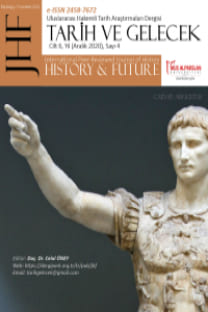İlk Yunan Parlementosu: Anabolu (Nafplion) Ağa(Vouleftikon) Camii
Anabolu, , Osmanlı Mimarisi, , Cami, Yunan Devleti, Parlamento Binası
First Greek Parliament: Anabolu (Nafplion) Ağa (Vouleftikon) Mosque
Anabolu, Ottoman Architecture, Mosque, Greek State, Parliament Building,
___
- Dimakopoulou, H., “Theodoros Vallianos, O mihanikos ke to ktiriou tou protou kinovoliou sto Nafplio (1796-1857), Sto protoi ellines tehnikoi epistimones Apeleftherosis, Athina 1976, s.115-122.
- Evliya Çelebi, Seyahatnâme, VIII, s.360.
- François-Charles-Hugues-Laurent Pouqueville, Voyage dans la Grèce, Paris 1820-21, s.167-168.
- Gell, William, Itinerary of Morea, London 1817, s. 181.
- Göyünç, Nejat, “XVIII. Yüzyılda Türk İdaresinde Nauplia (Anabolu) ve Yapıları”, İsmail Hakkı Uzunçarşılı’ya Armağan, Ankara 1976, s.461-485.
- Göyünç, Nejat, “Anabolu Maddesi”, TDV İslâm Ansiklopedisi, İstanbul, 1991, 3. Cild, s.105-106.
- Kalafati, El., “İ Poleodomia Tis Epanastasis: Nafplio 1822-1830”, Ta İstorika, t1, tef2, 1984, s.270, 272-274.
- Karouzou, S., To Naflio, Athina, 1979, s.59-60.
- Konstantinopoulos, X.G., Oi Paradosiakes Htistes tis Peloponnisou, Athina, 1983, s.18, 24, 159-161.
- Lambridinis, M.G., I Nafplia apo ton arheotaton hronon mehri ton kath imas, Nafplion, 2001, (a.ekd.1898), s.191-192, 263, 271-272, 317-319.
- Örenç, Ali Fuat, Yunanistan’ın Bağımsızlık Sürecinde Yok Edilen Mora Türkleri”, Uluslararası Suçlar ve Tarih, 2011, S.11/12, s.5-32.
- Piteros, Hr., “Nafplio”, A.D.54, 1999, B1, Hronika, s.148.
- Piteros, Hr., “Pote htistike to megalo tzami, Vouleftiko sto Nafplio”, Nafpliaka Analekta, 2007, s.135-142.
- Sonyel, Salâhi R. “Yunan Ayaklanması Günlerinde Mora’daki Türkler Nasıl Yok Edildiler?”, Belleten, LXII/233, (1998), s.107-120.
- Spiliotakis, K.K., “Ta en Nafplio ktiria vou Vouleftikou ke tou Ektelestikou, (1824-1826)”, Deltion tis Istorikes ke Ethnologikis Eterias tis Elladas 20 (1973), s.53-65.
- Vassiliou, Anastasia, “Vouleftiko Mosque”, Ottoman Architecture İn Greece, Hellenic Ministry of Culture, Directorate of Byzantine and Post-Byzantine Antiquites, 2008, s.126-127.
- Wheler, George, A Journey through Greece, London 1682, s.294.
- Yayın Aralığı: Yılda 4 Sayı
- Başlangıç: 2015
- Yayıncı: Celal ÖNEY
İlk Yunan Parlementosu: Anabolu (Nafplion) Ağa(Vouleftikon) Camii
Balshaj’s Weaponry during the centuries XIV-XV
Isparta’nın İlk Kadın Milletvekili Fatma Mihriban Erden’in Meclis Faaliyetleri (1983-1987)
İsnik Meclisi ve 1908-1910 Yillarinda İsa Boletin’in Rolü
Lushnja (Luşnia) Kongresi ve tarih Önemi (21 Ocak 1920)
Muhtar Azerbaycan Hükümeti (İran 1945-46) Kuruluş Süreci
Türk Yorgan Sanatı ve Şanlıurfa’da Geleneksel Yorgancılık
Ümit Buğrahan ÖZCAN, Ayşe BOZKAYA
Qeyser Eminpur’un Edebî Kişiliği, Eserleri ve Bi Bal Periden Adlı Eserinde İnsan ve Kitap
